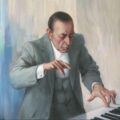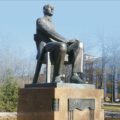- С.В.Рахманинов в молодости/ Rachmaninoff in his youth
- Сергей Рахманинов с женой Натальей Сатиной/ Sergei Rachmaninoff and his wife Natalya Satina
- Рукопись Рахманинова/ Rachmaninoff’s manuscript
- Портрет Рахманинова кисти А.Пирогова/ A.Pirogov’s “Portrait of Rachmaninoff”
- Памятник Рахманинову в Москве/ Monument to Rachmaninoff in Moscow
Throughout his career in music, Sergei Rachmaninoff established himself as a pianist, composer, and conductor, being extremely successful in all these roles. This fact alone would be enough to go down in the history of music. However, Rachmaninoff was not only a genius but also the genuine voice of Russia.
First lessons
Sergei was born in 1873 into a noble family that owned an estate in the Novgorod Governorate. His father was an amateur musician, so the interest in art was encouraged. Sergei’s grandmother often took him to visit ancient Novgorod churches, and church singing and the ringing of bells greatly influenced his creative style. When Rachmaninoff was nine years old, the family moved to St. Petersburg, and the boy entered the piano class at the junior department of the conservatory. Despite the obvious talent, Sergei did not study well: he often skipped classes. The parents decided to take their son to Moscow and settle in a private boarding school of a well-known teacher, professor of the Moscow Conservatory Nikolai Zverev.
In the autumn of 1885, Rachmaninoff moved to Moscow, enrolled in the third year of the junior department of the Moscow Conservatory. Clearly, the atmosphere in Moscow had a profound impact on the young musician: during his final exam in harmony, he impressed renowned composer Pyotr Tchaikovsky so much that the maestro gave him the highest mark with pluses on all sides. Rachmaninoff’s graduation work was an opera called Aleko and was based on Alexander Pushkin’s poem. Only a year later, the opera by a 19-year-old composer was staged at the Bolshoi Theatre. Rachmaninoff was hailed a new Mozart, and his career skyrocketed. However, this was followed by an unexpected twist of fate: the premiere of Rachmaninoff’s First Symphony in 1897 in Saint Petersburg was a total failure. This virtually devastated the young composer, and he wrote about his feelings at that point: “I was like a person who had been struck and had lost his head and his hands for a long time…”
The orchestra man
Rachmaninoff could overcome severe depression with the help of his talent, although not as a composer but as a conductor. He gladly accepted the offer from Savva Mamontov, patron of the arts, to become a conductor at the Moscow Private Russian Opera. There, Rachmaninoff gained experience in orchestra management, and most importantly, found like-minded people as Mamontov’s closest circle included the most talented artists and musicians of that time. There, Rachmaninoff met singer Feodor Chaliapin, and this meeting was a blessing for both of them. As the singer recalled, “When Rachmaninoff sits at the piano and accompanies, you have to say not ‘I sing’, but ‘we sing’.”
Rachmaninoff’s conducting talent was quickly recognized, and he was offered the position of Chief Conductor at the Bolshoi Theatre. In just two years (from 1904 to 1906), Rachmaninoff greatly improved the musical aspect of the performances. Moreover, he introduced a number of innovations: he changed the seating arrangement of the musicians in the orchestra for better acoustics and moved the conductor’s podium to where we usually see it today — to the barrier separating the orchestra pit from the audience. Such an arrangement enabled the conductor to see the orchestra. This is what one of his colleagues said about Rachmaninoff’s conducting talent: “He did not exaggerate the expressiveness of the music performed, he did not turn every crescendo into a Mont Blanc, he did not sweetly freeze at every diminuendo and ritardando, he did not invent shades that were not specified by the author, he did not want effects for the sake of effects. He had something more valuable, he knew what makes perhaps the main secret of any performance — the sense of proportion, and he performed not his own, but the music of the composer.”
The music of silence
Rachmaninoff brilliantly formulated his creative motto: “What is music?! It is a quiet moonlit night; it is the rustle of leaves; it is bells ringing in the evening; it is something that is born from the heart and goes to the heart; it is love!” This figurative description conveys the picturesque nature of Ivanovka — the estate in the Tambov province, which for many years was a true place of power for the composer. Ivanovka belonged to Rachmaninoff’s relatives — the Satin family. From childhood, Sergei was a welcome guest there. In 1902, Rachmaninoff married his cousin Natalya Satina, and since then Ivanovka became his home. Amidst the crystal silence of the Russian countryside and gardens of blooming lilacs, he composed 24 preludes, 9 etudes, 2 sonatas, and 49 romances. “I write the music that I hear inside myself, and I write it as naturally as possible. I am a Russian composer, and my homeland has left its mark on my personality and views. My music is a product of my personality, and therefore it is Russian music,” Rachmaninoff claimed. Indeed, piano concertos No. 2 and 3 are genetically linked to Russian church singing. Critics found similarities with the melodies of the Znamenny Chant in the third concerto. However, Rachmaninoff said that he did not consciously use elements of folk or church singing: “It happened naturally! I wanted to ‘sing’ the melody on the piano, like singers do — and find a suitable, or rather, an orchestral accompaniment that does not drown this ‘singing’.”
In 1915, Rachmaninoff wrote one of his major works, All-Night Vigil. It took him only two weeks to complete this extensive piece. Probably, this is how the composer could channel his restlessness into creative expression during the ongoing World War I. Rachmaninoff drew inspiration from ancient monophonic chants of the Russian church, but his All-Night Vigil sounds really modern. The premiere at the Noble Assembly Hall in Moscow was tremendously successful: All-Night Vigil became the major musical event of 1915 and an outstanding work for all times. Vladimir Minin, the President of the Moscow State Academic Chamber Choir, notes that Rachmaninoff reached an unparalleled height in this work: “No one has been able to surpass him in terms of scope and craftsmanship in this piece to this day. Rachmaninoff brought his symphonic thinking into choral music. The piece has not only religious significance. It is spiritual music. And, of course, it is a tremendous contribution not only to Russian, but also to world music.”
Hands that worth a million
After the revolution of 1917, Rachmaninoff left Russia, and it was a terrible blow for the musician. In Europe, and later in the USA, Rachmaninoff performed a lot as a pianist, but hardly composed, as if this talent could not reveal itself outside his native land. Rachmaninoff gave an incredible number of concerts — more than 60 performances per year. His popularity was enormous: crowds of reporters followed Rachmaninoff on tour. Once in a small American town, a local photographer tried to take a picture of Rachmaninoff while the composer was having lunch. The irritated musician covered his face with his hands, and on the next day the photo appeared in the newspaper with the caption “Hands that worth a million.” The reporter did not lie — Rachmaninoff had truly exceptional hands: he could cover 12 white keys with his fingers at once. Those amazing hands earned incredible sums, which the musician spent not only on technological novelties that he adored but also on helping those who turned to him. The composer supported his fellow emigrants and sent food to his homeland: hundreds of Rachmaninoff’s parcels, each weighing no less than seventy kilos, saved the lives of many Russian people during the hungry years after the revolution. Rachmaninoff was greatly concerned about the beginning Great Patriotic War: as early as in 1941, he donated the entire earnings from a concert at Carnegie Hall to purchase equipment for a hospital that treated Soviet soldiers. The composer made his donations anonymously, with the words “From one of the Russians, a modest contribution to the Russian people in their struggle against the enemy.” In this regard, the words of pianist Josef Hofmann seem very true: “Rachmaninoff was made of steel and gold: steel in his hands and gold in his heart.”
Rachmaninoff never lost touch with Russia. In his estate, Senar, the musician planted birch trees and tried to recreate the atmosphere of his beloved Ivanovka in every possible way. Rachmaninoff always spoke Russian in his family and welcomed compatriots who visited him on his tours. Rachmaninoff desperately wanted to return to his homeland, but the Great Patriotic War and illness interfered with this. Rachmaninoff died in the spring of 1943 and was buried near New York. In 1958, young pianist Van Cliburn planted a white lilac seedling on his grave that had been brought from Russia — a farewell from the country that resonates in every Rachmaninoff’s note.
Tatiana Borisova





